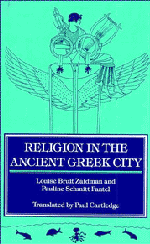Book contents
- Frontmatter
- Contents
- List of illustrations
- Author's preface to the English translation
- Translator's introduction
- List of sources
- PART I Introduction: How should we study Greek civic religion?
- PART II Cult-practices
- 4 Rituals
- 5 Religious personnel
- 6 Places of cult
- 7 Rites of passage
- 8 Settings of religious life
- 9 Religion and political life
- 10 The festival system: the Athenian case
- 11 The Panhellenic cults
- PART III Systems for representing the divine
- PART IV Envoi
- Appendixes
- Bibliography
- Index
9 - Religion and political life
Published online by Cambridge University Press: 05 June 2012
- Frontmatter
- Contents
- List of illustrations
- Author's preface to the English translation
- Translator's introduction
- List of sources
- PART I Introduction: How should we study Greek civic religion?
- PART II Cult-practices
- 4 Rituals
- 5 Religious personnel
- 6 Places of cult
- 7 Rites of passage
- 8 Settings of religious life
- 9 Religion and political life
- 10 The festival system: the Athenian case
- 11 The Panhellenic cults
- PART III Systems for representing the divine
- PART IV Envoi
- Appendixes
- Bibliography
- Index
Summary
CITIES AND THEIR PATRON DEITIES
Every Greek city placed itself under the patronage of a god or goddess: Poseidon at Corinth, Hera at Argos, Zeus at Kos and Athene at Sparta, Tegea and Athens, to take just half-a-dozen cases. The patron divinity might bear an epithet that explicitly signalled his or her protective function, for example Polias (‘Of the City’) at Athens, Poliakhos (‘City-holding’) at Sparta; and sometimes mythical narratives told of a contest between gods for the patronage of a city. At Athens, for instance, the divine contestants were Athene and Poseidon: Athene won, but a compromise was later struck by granting both divinities space within the Erekhtheion temple on the Akropolis (see Appendix II).
Each city, too, had its heroes, sometimes founder-heroes or eponymous founder-heroes. Their cults, distinct from divine cult, had their own marked individuality from city to city, while heroic myths might also function as a way of conceptualizing the origins of a city's history (cf. chapter 13).
Religion, however, did more than just put a divine gloss on civic life. It impregnated each and every civic activity. As we saw in Part I, one of the Greek city's distinguishing marks was that it recognized no separation between the sacred and the profane, the religious and the secular, of the sort with which we are familiar. Such a dichotomy would have been meaningless to the Greeks, since in their view most human actions had a religious dimension.
- Type
- Chapter
- Information
- Religion in the Ancient Greek City , pp. 92 - 101Publisher: Cambridge University PressPrint publication year: 1992

